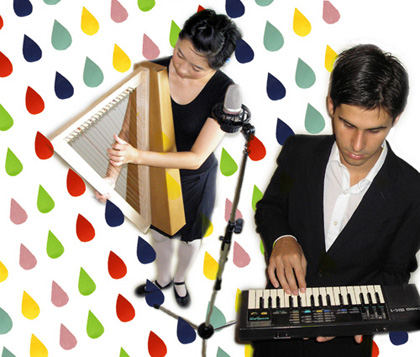

LULLATONE
The 2003 Lullatone release Computer Recital shows Shawn James Seymour playing a child's colourful glockenspiel, an apt visual analogue to his innocent, child-like music. Created entirely using gentle sine waves, its simple music box melodies and lullabies distinguished the recording from others dotting the electronica landscape. His latest Little Songs About Raindrops is no less bucolic but its instrumental palette is richer, the sine tones having expanded to a tiny orchestra of toy instruments. On the eve of its release, the 22-year-old agreed to discuss the new recording, his musical background, and what it's like to be a permanent resident of Nagoya, Japan.
Having grown up in Louisville, Kentucky, last year's move to Japan might seem surprising but Shawn's account of his background makes it seem natural. He explains that a lack of formal musical education didn't discourage his youthful exploration of experimental methods. “I used to make a lot of songs with toy keyboards using two cassette decks, and, following high school, I bought a used 8-track cassette recorder and started experimenting by flipping tapes to make backwards melodies and putting microphones on things to see how they sounded if I tapped them. During this time I bought a bunch of toy instruments from thrift stores. (My favorite keyboard for a long time now has been my Casio SK1.) I started making more and more music and playing solo at art gallery openings when I was about 17 or 18. The style I'd developed was pretty similar to Lullatone because it was mellow and slow and instrumental. When I turned 20, I moved to Osaka to go to school for a year, and, as I couldn't take all of my toy instruments with me, I took one SK1. So, as a matter of necessity, my music became less complicated (and better) and, when I realized this, I started using sine waves because they're so basic—hence the formation of the original Lullatone-sound. I met my girlfriend Yoshimi / Sookmi (she has two different names) when she was studying in America but when she had to return to Japan, she said I should come with her. So I said OK and got accepted to a school here. I realized then how much I liked Japan and so came back as soon as I finished university.”
When the topic of influences arises (Erik Satie and Steve Reich are often cited), Shawn replies, “I think my biggest influence is my girlfriend because most of the Lullatone songs I've released started out as little lullabies I made for her. I would always work on music after she went to sleep so, naturally, I tried to make something quiet and pleasant for her to sleep to. But, at the same time, I was always waking her up in the middle of the night to say “Hey, check out this new song I made for you to sleep to!””
Queried about his affiliation with Nobukazu Takemura (Seymour released My Petit Melodies in 2003 on Takemura's Childisc Recordings label), Seymour replies, “Takemura-san and I don't get to meet very often because we live in different cities and he is a very busy person. He invited me to play last year at an event he organized called Childisc Funfair. Of all the Childisc artists, I meet with Yabemilk and Aki Tsuyuko the most. I listen to Aki-san's music as well as releases on Miroque's wonderful Cachamai label, and I really like Yuichiro Fujimoto. He just released a CD on smalltown supersound from Norway and makes incredibly beautiful sparse music. Other than that I like Asuna, an organ player from Tokyo , and Asana, a post-rock band from Nagoya that uses a lot of ethnic instruments like gamelans and a Chinese version of a koto.”
Our talk turns to the new record and Shawn describes its instrumental approach. “There are many more instruments, the most important being my music box,” he says, “It's a little difficult to explain, but basically I punch holes in a strip of paper with a staff printed on it, and feed that through the box and it plays my composition. I also used a tiny toy metalophone, accordion, toy piano, cymbals, a toy cassette tape recorder, and some sine tones. I recorded all of Little Songs About Raindrops in my tiny one-room apartment.” Not only has the Lullatone sound changed but Seymour's also joined by numerous guests. Ryan Stearman and Yusuke Asano play ukuleles, Nick Cox plays viola, and Keiichi Sugimoto adds guitar harmonics. (Sugimoto is a member of the bands Fonica and Minamo and also runs the Japan label Cubic Music.) Having previously appeared on Computer Recital's “Tracing,” Yoshimi (Tomida) adds vocals to four songs, and also sings and plays accordion at live Lullatone performances.
When asked about future plans, he admits that he's taking a bit of a break after having released three albums in one year and so has no plans to tour at the moment. For now, Shawn's content with things just as they are. “Simplicity is really appreciated in Japan and as far as I'm concerned I'm in the center of the world. Plus Nagoya is a great place to live when it comes to playing shows because it's in between Tokyo and Osaka.”
August 2004
![]()